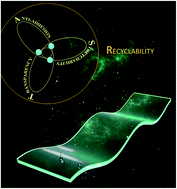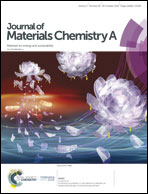Endowing recyclability to anti-adhesion materials via designing physically crosslinked polyurethane†
Abstract
The existing principles regarding the design of anti-adhesion materials involving molecular thickness, crystallinity, thermosetting chemical crosslinking, sophisticated structures, and complex compositions significantly restrict the recyclability of these functional materials. Herein, we report a homogeneous thermoplastic film generated from a physically crosslinked linear polyurethane that exhibits anti-adhesion performance against water and various oily liquids, while exhibiting facile recyclability via dissolution in selective solvents or under slight heating, and these treatments could also heal the material if it became damaged. Moreover, the film exhibits a maximal fracture strain exceeding 1570% with a tensile strength of over 5.66 MPa, high optical transparency with a transmittance exceeding 98.5% at a thickness of 0.5 mm, and it can bond strongly to various kinds of substrates. Due to the convenient preparation and excellent recyclability of this novel anti-adhesion polymer-based material, it may have significant potential for numerous applications. In addition, this work may ultimately allow researchers to endow various other anti-adhesion materials with facile recyclability, thus improving resource utilization and abating environmental pollution.



 Please wait while we load your content...
Please wait while we load your content...